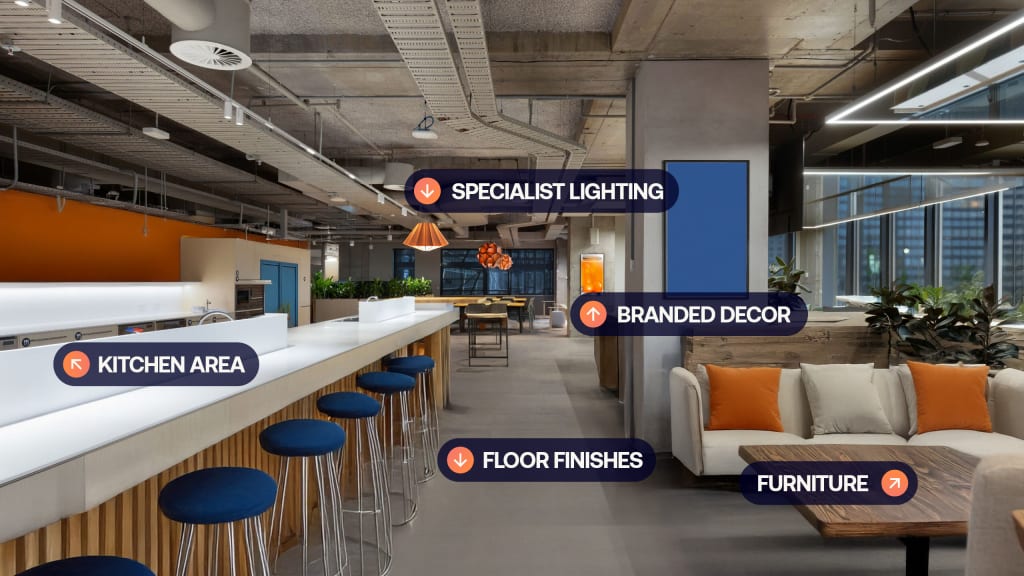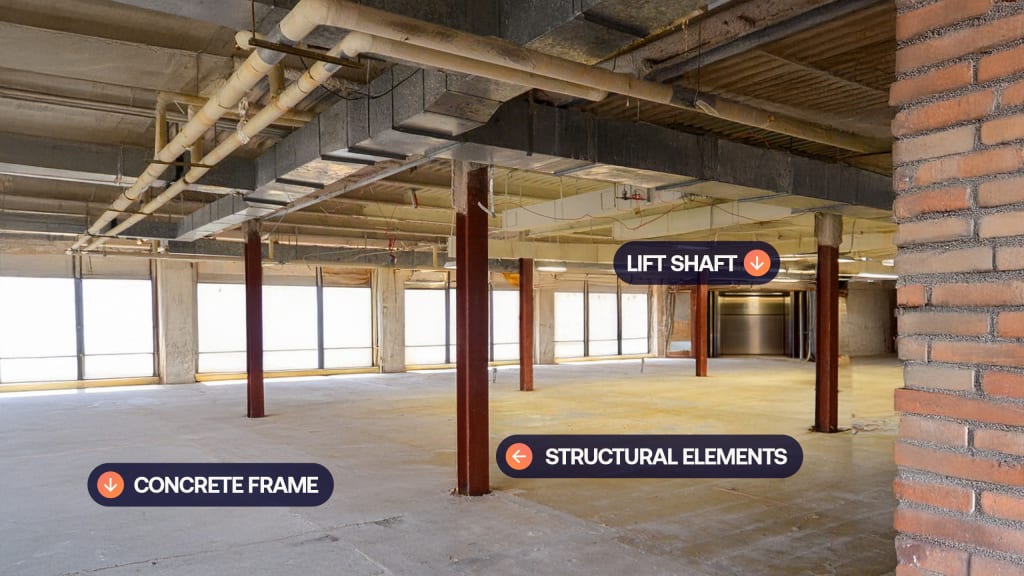What’s the difference between Cat A and Cat B fit out
When moving into a new office, businesses are faced with the prospect of fitting it out and making it their own. The term ‘fit out’ refers to the process of making an empty space inhabitable for a tenant business, with a focus on ‘creating from scratch’ rather than renovating or refurbishing an existing workspace.
There are different types of office fit out to be aware of, but Cat B fit out is the type that most companies will know as this refers to the design and decoration of an office space. The other types that will be covered in more detail throughout the article to explain what each Category, or ‘Cat’, your office has been fitted out to. It’s important to understand how these pathways differ, so you understand what the specific terminology means and what condition you are taking your new office space in.
Here we explain the key differences, features and benefits of each fit out category, with best-in-class examples and guidance on how to choose the right approach for your company.
What are the different office fit out categories?
When it comes to office fit outs, the most common categories are known as Cat A and Cat B. Other options include Shell & Core and CAT A+. Together, these four classifications encompass the full spectrum of stages and services involved in workspace creation.
There are also different approaches to procurement, such as design & build and traditional procurement.
By getting to grips with the key elements of each option, you can assess which will best meet your specific requirements as an occupier and employer.
What’s a Cat A fit out?
A Category A, or Cat A, fit out is a rudimentary operational fit out that provides you with an unfurnished but functional office space. Focused on the installation of key infrastructure and services, a Cat A fit out builds on the framework of Shell & Core (see below) with a view to readying office space for corporate occupancy.
Key features of a Cat A fit out?
The Cat A option ensures you have all the basics required for a functioning office, but without the secondary design finishes and flourishes which ‘complete’ the fit out process. A Cat A fit out will typically comprise wall coverings, grid ceilings and raised access flooring, plus electrical services, lighting, sockets, plumbing, reception areas, elevators and other essential features.
The process is usually carried out by a landlord in preparation for commercial letting. Once the space is ready, a tenant business will inhabit the premises. They will then most likely conduct a Cat B fitout (see below), installing customised interior components to create a fully functioning work environment.
What does a Cat A fit out look like?

What are the benefits of a Cat A office fit out?
It’s often said that a Cat A fitout provides a ‘blank canvas’ on which new tenants can express themselves. By providing essential infrastructure and core functionality, a Cat A fit out lays the foundations for a company to create new workspace tailored to its needs and ambitions.
From a practical perspective, Cat A fit outs make it easier for a landlord to let their space as well as carry out any important upgrades to things like power and mechanical functionality. For the end-user, Cat A gives you the chance to take on a fresh, blank canvas with a view to fully customising and transforming the space into how you need it. Cat A standard means you’re guaranteed a functional, practical and presentable base for your business.
What’s a Cat B fit out?
A Category B, or Cat B, fit out describes the process of transforming an empty but functioning space into a fully customised working environment, complete with design features and furnishings. Usually following on from a Cat A fit out, Cat B results in a finished commercial space ready for business occupancy and operation.
Key features of a Cat B office fit out?
Whereas Cat A fit outs are typically conducted by a landlord, Cat B fit outs are usually carried out by the tenant in collaboration with an architect or design firm. Design specifications are tailored precisely to the needs of the tenant business, with installed features including partitions, meeting rooms, offices, breakout zones, storage and reception areas. Any specialist IT, comms and audiovisual equipment can be incorporated at this stage as well.
The Cat B process includes final design decisions relating to ceilings, floors and walls, plus the installation of kitchen areas, tea points, cabinets and workstations. It also encompasses the selection and procurement of desks, chairs and other office furniture, plus interior finishes such as artwork, decorative lighting, wall hangings and biophilia, along with any corporate branding.
What does a Cat B fit out look like?

What are the benefits of a Cat B fit out?
A Cat B fit out is designed specifically to your people’s needs – this is your own dedicated space. It enables a tenant to work in a workspace that is tailored to their ways of working and once you move in, you can start working in an environment entirely designed around your organisation.
The other great benefit of Cat B is that workspace is aligned to the specific requirements of the tenant business, with all features and areas customised to enhance productivity. As occupier and tenant, you will be involved in the Cat B design and planning process, meaning you will move into a fully personalised and purpose-built workspace. Your new office will also reflect your organisation’s brand values, which in turn will drive workforce engagement and performance. In short, it will feel like home.
What is a Shell & Core fit out?
Shell & Core is the most basic category of fit out for a commercial building. As the name suggests, the process covers a building’s envelope, shell and core structural elements – the bare essentials, which are typically installed before any occupancy agreements have been made.
Key features of a Shell & Core fit out?
A Shell & Core fit out is conducted by a developer or landlord. It precedes a Cat A fit out and includes core structural features such as windows, doors, roofs and external walls. Fire protection systems, insulation and basic services, such as plumbing and electrics, may also be installed. Other key features include lobbies, lift shafts and the surrounding concrete and metal frame. While a completed Shell & Core space will not be ready for use, it’s the first step on the way to creating a rentable commercial space.
What does a shell & core look like?

What are the benefits of a Shell & Core fit out?
A Shell & Core fit out provides a raw, flexible space that can be adapted to a range of tenant uses. Whether the next stage of spatial development is conducted by the developer, or by the new tenant in collaboration with a construction company, Shell & Core provides a base template from which new infrastructure and design features can be created.
What’s a Cat A+ office fit out?
Somewhere between Cat A and Cat B is a hybrid concept known as Cat A+. A Cat A+ fit out provides a finish similar to Cat A, but with a greater level of completion and functionality. Also referred to as a ‘Plug and Play’ option, Cat A+ enables tenants to move into new, functional space and begin working without delay, with only minor adjustments and updates required.
Key features of a Cat A+ fit out
A Cat A+ fit out is typically conducted by landlords as a way of attracting new tenants who might be reluctant to spend money on extensive developments. While not quite reaching the fully furnished levels of Cat B, Cat A+ includes features such as furniture, workspace, pre-fitted kitchens and toilets, meeting rooms, breakout spaces, air conditioning and IT infrastructure.
What does Cat A+ look like?

What are the benefits of a Cat A+ fit out?
One of the key benefits of a Cat A+ fit out is the fact that upfront costs and investment are minimised, as there are very few adjustments for tenants to make upon arrival. The Cat A+ route also enables immediate occupation, so tenants can get straight on with running their business from their new space.
For tenants who don’t want or can’t commit to a full Cat B finish, Cat A+ provides a good alternative, especially in a co-working environment. It’s also a popular option for landlords offering flexible space within build-to-lease schemes.
In fact, flexibility is one of the major advantages of Cat A+. As the space in question changes little from tenant to tenant, businesses can move in and out quickly and don’t have to commit to long-lease contracts. For landlords, this means faster turnaround between clients, higher rates and limited spatial vacancies.
What are the differences between a Cat A and Cat B office fit-out?
Workplace strategy takes a planned approach to optimize the physical work environment, aligning employee needs, business goals, and space utilization. The aim is to maximize efficiency, foster collaboration, and enhance overall productivity within the workspace.
Ask yourself, Is the built environment central to my project’s success, business growth, or operational efficiencies? If the answer is yes, then a strategy-focused approach may be the most effective path forward. Many skilled workplace strategists have experience as consultants (and vice versa), allowing them to bring a wide range of skills to the table when necessary. A strategist can also assemble a broader team and connect you with the best partners to develop your project, ensuring the right skills are applied at every stage—whether that’s data capture, analysis, or design.
Which is the right option for your business?
The simplest way to think about Cat A and Cat B fit outs is that usually a landlord would be responsible for a Cat A fit out and a tenant would be responsible for a Cat B fit out. There are obviously nuances and each scenario can be different but as a tenant your main focus will usually be on Cat B fit out.
Cat A is an empty office space with the addition of basic functionality such as power, heating and air conditioning plus raised access floors and suspended ceilings. This enables the landlord to provide a blank canvas and ensure the essentials of a space are to a standard. A Cat B space on the other hand will look like a finished space that has been designed with furniture, walls and other soft finishes that are bespoke to specific companies.
If you need any guidance or support in selecting your office fit-out, please get in contact, or download our free guide to office design companies to help with your office fit out.
People also ask: office fit out categories
A Cat A fit out will take less time to complete, meaning you won’t have to wait so long before your new space is ready. But while core functions will be in place, further adjustments and additions will be required before you can enjoy a fully operational workspace. A Cat B fit out will take longer to complete, due to the greater level of customisation and design involved. But once it’s done, you can move in and start working straight away.
Your decision may well be guided by cost. As the more basic option, Cat A is naturally less expensive than Cat B. But remember, if you can’t afford Cat B and need greater functionality than Cat A, Cat A+ could be a happy halfway house.
Discover my workplace through an external lens.
It might be time to rethink your office. See how a smarter, more dynamic workspace can power up your people.
Discuss your brief with an expert
By submitting your email address, you agree to our Privacy Policy and Terms & Conditions.


